Harry Houdini
Harry Houdini (/huːˈdiːni/; born Erik Weisz, later Ehrich Weiss or Harry Weiss; March 24, 1874 – October 31, 1926) was a Hungarian-born American illusionist and stunt performer, noted for his sensational escape acts. He first attracted notice in vaudeville in the United States and then as "Harry 'Handcuff' Houdini" on a tour of Europe, where he challenged police forces to keep him locked up. Soon he extended his repertoire to include chains, ropes slung from skyscrapers, straitjackets under water, and having to escape from and hold his breath inside a sealed milk can with water in it.
Harry Houdini | |
|---|---|
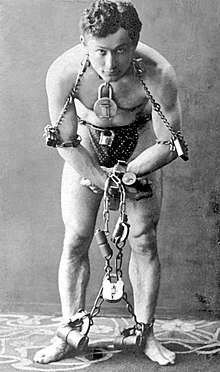 Houdini in 1899 | |
| Born | Erik Weisz March 24, 1874 Budapest, Austria-Hungary (now Hungary) |
| Died | October 31, 1926 (aged 52) Detroit, Michigan, U.S. |
| Cause of death | Peritonitis[1] |
| Occupation | Illusionist, escapologist, stunt performer |
| Years active | 1891–1926 |
| Spouse(s) | [2] |
| Relatives | Theodore Hardeen (brother) |
| Signature | |
In 1904, thousands watched as he tried to escape from special handcuffs commissioned by London's Daily Mirror, keeping them in suspense for an hour. Another stunt saw him buried alive and only just able to claw himself to the surface, emerging in a state of near-breakdown. While many suspected that these escapes were faked, Houdini presented himself as the scourge of fake spiritualists. As President of the Society of American Magicians, he was keen to uphold professional standards and expose fraudulent artists. He was also quick to sue anyone who imitated his escape stunts.
Houdini made several movies but quit acting when it failed to bring in money. He was also a keen aviator and aimed to become the first man to fly a plane in Australia.
Early life
Erik Weisz was born in Budapest to a Jewish family.[3] His parents were Rabbi Mayer Sámuel Weisz (1829–1892) and Cecília Steiner (1841–1913). Houdini was one of seven children: Herman M. (1863–1885) who was Houdini's half-brother by Rabbi Weisz's first marriage; Nathan J. (1870–1927); Gottfried William (1872–1925); Theodore (1876–1945);[4] Leopold D. (1879–1962); and Carrie Gladys (1882–1959),[5] who was left almost blind after a childhood accident.[6]
Weisz arrived in the United States on July 3, 1878, on the SS Fresia with his mother (who was pregnant) and his four brothers.[7] The family changed their name to the German spelling Weiss, and Erik became Ehrich. The family lived in Appleton, Wisconsin, where his father served as Rabbi of the Zion Reform Jewish Congregation.
According to the 1880 census, the family lived on Appleton Street in an area that is now known as Houdini Square.[8] On June 6, 1882, Rabbi Weiss became an American citizen. Losing his job at Zion in 1882, Rabbi Weiss and family moved to Milwaukee and fell into dire poverty.[9] In 1887, Rabbi Weiss moved with Ehrich to New York City, where they lived in a boarding house on East 79th Street. He was joined by the rest of the family once Rabbi Weiss found permanent housing. As a child, Ehrich Weiss took several jobs, making his public début as a 9-year-old trapeze artist, calling himself "Ehrich, the Prince of the Air". He was also a champion cross country runner in his youth.
Magic career
When Weiss became a professional magician he began calling himself "Harry Houdini", after the French magician Jean Eugène Robert-Houdin, after reading Robert-Houdin's autobiography in 1890. Weiss incorrectly believed that an i at the end of a name meant "like" in French. In later life, Houdini claimed that the first part of his new name, Harry, was an homage to Harry Kellar, whom he also admired, though it was more likely adapted from "Ehri", a nickname for "Ehrich", which is how he was known to his family.[10]
When he was a teenager, Houdini was coached by the magician Joseph Rinn at the Pastime Athletic Club.[11]
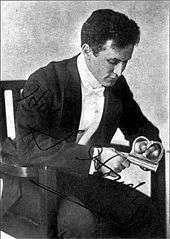
Houdini began his magic career in 1891, but had little success.[12] He appeared in a tent act with strongman Emil Jarrow.[13] He performed in dime museums and sideshows, and even doubled as "The Wild Man" at a circus. Houdini focused initially on traditional card tricks. At one point, he billed himself as the "King of Cards".[14] Some – but not all – professional magicians would come to regard Houdini as a competent but not particularly skilled sleight-of-hand artist, lacking the grace and finesse required to achieve excellence in that craft.[15][16] He soon began experimenting with escape acts.
In 1894, while performing with his brother "Dash" (Theodore) at Coney Island as "The Brothers Houdini", Houdini met a fellow performer, Wilhelmina Beatrice "Bess" Rahner. Bess was initially courted by Dash, but she and Houdini married, with Bess replacing Dash in the act, which became known as "The Houdinis". For the rest of Houdini's performing career, Bess worked as his stage assistant.
Houdini's big break came in 1899 when he met manager Martin Beck in St. Paul, Minnesota. Impressed by Houdini's handcuffs act, Beck advised him to concentrate on escape acts and booked him on the Orpheum vaudeville circuit. Within months, he was performing at the top vaudeville houses in the country. In 1900, Beck arranged for Houdini to tour Europe. After some days of unsuccessful interviews in London, Houdini's British agent Harry Day helped him to get an interview with C. Dundas Slater, then manager of the Alhambra Theatre. He was introduced to William Melville and gave a demonstration of escape from handcuffs at Scotland Yard.[17] He succeeded in baffling the police so effectively that he was booked at the Alhambra for six months. His show was an immediate hit and his salary rose to $300 a week.[18]
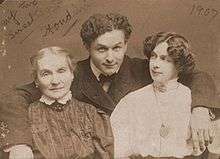
Between 1900 and 1920 he appeared in theatres all over Great Britain performing escape acts, illusions, card tricks and outdoor stunts, becoming one of the world's highest paid entertainers.[19] He also toured the Netherlands, Germany, France, and Russia and became widely known as "The Handcuff King". In each city, Houdini challenged local police to restrain him with shackles and lock him in their jails. In many of these challenge escapes, he was first stripped nude and searched. In Moscow, he escaped from a Siberian prison transport van, claiming that, had he been unable to free himself, he would have had to travel to Siberia, where the only key was kept. In Cologne, he sued a police officer, Werner Graff, who alleged that he made his escapes via bribery.[20] Houdini won the case when he opened the judge's safe (he later said the judge had forgotten to lock it). With his new-found wealth, Houdini purchased a dress said to have been made for Queen Victoria. He then arranged a grand reception where he presented his mother in the dress to all their relatives. Houdini said it was the happiest day of his life. In 1904, Houdini returned to the U.S. and purchased a house for $25,000 (equivalent to $711,389 in 2019), a brownstone at 278 W. 113th Street in Harlem, New York City.[21]
While on tour in Europe in 1902, Houdini visited Blois with the aim of meeting the widow of Emile Houdin, the son of Jean Eugène Robert-Houdin, for an interview and permission to visit his grave. He did not receive permission but still visited the grave.[22] Houdini believed that he had been treated unfairly and later wrote a negative account of the incident in his magazine, claiming he was "treated most discourteously by Madame W. Emile Robert-Houdin".[22] In 1906, he sent a letter to the French magazine L'Illusionniste stating: "You will certainly enjoy the article on Robert Houdin I am about to publish in my magazine. Yes, my dear friend, I think I can finally demolish your idol, who has so long been placed on a pedestal that he did not deserve."[23]
In 1906, Houdini created his own publication, the Conjurers' Monthly Magazine.[24] It was a competitor to The Sphinx, but was short-lived and only two volumes were released until August 1908. Magic historian Jim Steinmeyer has noted that "Houdini couldn't resist using the journal for his own crusades, attacking his rivals, praising his own appearances, and subtly rewriting history to favor his view of magic."[25]
From 1907 and throughout the 1910s, Houdini performed with great success in the United States. He freed himself from jails, handcuffs, chains, ropes, and straitjackets, often while hanging from a rope in sight of street audiences. Because of imitators, Houdini put his "handcuff act" behind him on January 25, 1908, and began escaping from a locked, water-filled milk can. The possibility of failure and death thrilled his audiences. Houdini also expanded his repertoire with his escape challenge act, in which he invited the public to devise contraptions to hold him. These included nailed packing crates (sometimes lowered into water), riveted boilers, wet sheets, mail bags,[26] and even the belly of a whale that had washed ashore in Boston. Brewers in Scranton, Pennsylvania and other cities challenged Houdini to escape from a barrel after they filled it with beer.[27]
Many of these challenges were arranged with local merchants in one of the first uses of mass tie-in marketing. Rather than promote the idea that he was assisted by spirits, as did the Davenport Brothers and others, Houdini's advertisements showed him making his escapes via dematerializing, although Houdini himself never claimed to have supernatural powers.[28]
After much research, Houdini wrote a collection of articles on the history of magic, which were expanded into The Unmasking of Robert-Houdin published in 1908. In this book he attacked his former idol Robert-Houdin as a liar and a fraud for having claimed the invention of automata and effects such as aerial suspension, which had been in existence for many years.[29][30] Many of the allegations in the book were dismissed by magicians and researchers who defended Robert-Houdin. Magician Jean Hugard would later write a full rebuttal to Houdini's book.[31][32][33]
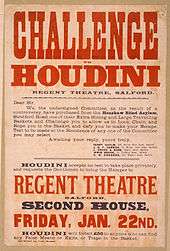
In 1913, Houdini introduced the Chinese Water Torture Cell, in which he was suspended upside-down in a locked glass-and-steel cabinet full to overflowing with water, holding his breath for more than three minutes. He would go on performing this escape for the rest of his life.
During his career, Houdini explained some of his tricks in books written for the magic brotherhood. In Handcuff Secrets (1909), he revealed how many locks and handcuffs could be opened with properly applied force, others with shoestrings. Other times, he carried concealed lockpicks or keys. When tied down in ropes or straitjackets, he gained wiggle room by enlarging his shoulders and chest, moving his arms slightly away from his body.[28]
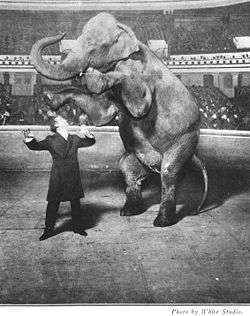
His straitjacket escape was originally performed behind curtains, with him popping out free at the end. Houdini's brother (who was also an escape artist, billing himself as Theodore Hardeen) discovered that audiences were more impressed when the curtains were eliminated so they could watch him struggle to get out. On more than one occasion, they both performed straitjacket escapes while dangling upside-down from the roof of a building in the same city.[28]
For most of his career, Houdini was a headline act in vaudeville. For many years, he was the highest-paid performer in American vaudeville. One of Houdini's most notable non-escape stage illusions was performed at the New York Hippodrome, when he vanished a full-grown elephant from the stage.[34] He had purchased this trick from the magician Charles Morritt.[35][36] In 1923, Houdini became president of Martinka & Co., America's oldest magic company. The business is still in operation today.
He also served as President of the Society of American Magicians (a.k.a. S.A.M.) from 1917 until his death in 1926. Founded on May 10, 1902, in the back room of Martinka's magic shop in New York, the Society expanded under the leadership of Harry Houdini during his term as National President from 1917 to 1926. Houdini was magic's greatest visionary. He sought to create a large, unified national network of professional and amateur magicians. Wherever he traveled, he gave a lengthy formal address to the local magic club, made speeches, and usually threw a banquet for the members at his own expense. He said "The Magicians Clubs as a rule are small: they are weak ... but if we were amalgamated into one big body the society would be stronger, and it would mean making the small clubs powerful and worthwhile. Members would find a welcome wherever they happened to be and, conversely, the safeguard of a city-to-city hotline to track exposers and other undesirables."
For most of 1916, while on his vaudeville tour, Houdini had been recruiting—at his own expense—local magic clubs to join the S.A.M. in an effort to revitalize what he felt was a weak organization. Houdini persuaded groups in Buffalo, Detroit, Pittsburgh, and Kansas City to join. As had happened in London, he persuaded magicians to join. The Buffalo club joined as the first branch, (later assembly) of the Society. Chicago Assembly No. 3 was, as the name implies, the third regional club to be established by the S.A.M., whose assemblies now number in the hundreds. In 1917, he signed Assembly Number Three's charter into existence, and that charter and this club continue to provide Chicago magicians with a connection to each other and to their past. Houdini dined with, addressed, and got pledges from similar clubs in Detroit, Rochester, Pittsburgh, Kansas City, Cincinnati and elsewhere. This was the biggest movement ever in the history of magic. In places where no clubs existed, he rounded up individual magicians, introduced them to each other, and urged them into the fold.
By the end of 1916, magicians' clubs in San Francisco and other cities that Houdini had not visited were offering to become assemblies. He had created the richest and longest-surviving organization of magicians in the world. It now embraces almost 6,000 dues-paying members and almost 300 assemblies worldwide. In July 1926, Houdini was elected for the ninth successive time President of the Society of American Magicians. Every other president has only served for one year. He also was President of the Magicians' Club of London.[37]
In the final years of his life (1925/26), Houdini launched his own full-evening show, which he billed as "Three Shows in One: Magic, Escapes, and Fraud Mediums Exposed".[38]
Notable escapes
Mirror challenge

In 1904, the London Daily Mirror newspaper challenged Houdini to escape from special handcuffs that it claimed had taken Nathaniel Hart, a locksmith from Birmingham, five years to make. Houdini accepted the challenge for March 17 during a matinée performance at London's Hippodrome theater. It was reported that 4000 people and more than 100 journalists turned out for the much-hyped event. The escape attempt dragged on for over an hour, during which Houdini emerged from his "ghost house" (a small screen used to conceal the method of his escape) several times. On one occasion he asked if the cuffs could be removed so he could take off his coat. The Mirror representative, Frank Parker, refused, saying Houdini could gain an advantage if he saw how the cuffs were unlocked. Houdini promptly took out a pen-knife and, holding the knife in his teeth, used it to cut his coat from his body. Some 56 minutes later, Houdini's wife appeared on stage and gave him a kiss. Many thought that in her mouth was the key to unlock the special handcuffs. However, it has since been suggested that Bess did not in fact enter the stage at all, and that this theory is unlikely due to the size of the 6-inch key.[39] Houdini then went back behind the curtain. After an hour and ten minutes, Houdini emerged free. As he was paraded on the shoulders of the cheering crowd, he broke down and wept. Houdini later said it was the most difficult escape of his career.[40]
After Houdini's death, his friend Martin Beck was quoted in Will Goldston's book, Sensational Tales of Mystery Men, as admitting that Houdini was bested that day and had appealed to his wife, Bess, for help. Goldston goes on to claim that Bess begged the key from the Mirror representative, then slipped it to Houdini in a glass of water. It was stated in the book The Secret Life of Houdini that the key required to open the specially designed Mirror handcuffs was 6 inches long, and could not have been smuggled to Houdini in a glass of water. Goldston offered no proof of his account, and many modern biographers have found evidence (notably in the custom design of the handcuffs) that the Mirror challenge may have been arranged by Houdini and that his long struggle to escape was pure showmanship.[41]
This escape was discussed in depth on the Travel Channel's Mysteries at the Museum in an interview with Houdini expert, magician and escape artist Dorothy Dietrich of Scranton's Houdini Museum.[42]
A full-sized design of the same Mirror Handcuffs, as well as a replica of the Bramah style key for it, is on display to the public at The Houdini Museum in Scranton, Pennsylvania.[43][44] This set of cuffs is believed to be one of only six in the world, some of which are not on display.[45]
Milk Can Escape
In 1908, Houdini introduced his own original act, the Milk Can Escape.[46] In this act, Houdini was handcuffed and sealed inside an oversized milk can filled with water and made his escape behind a curtain. As part of the effect, Houdini invited members of the audience to hold their breath along with him while he was inside the can. Advertised with dramatic posters that proclaimed "Failure Means A Drowning Death", the escape proved to be a sensation.[47] Houdini soon modified the escape to include the milk can being locked inside a wooden chest, being chained or padlocked. Houdini performed the milk can escape as a regular part of his act for only four years, but it has remained one of the acts most associated with him. Houdini's brother, Theodore Hardeen, continued to perform the milk can escape and its wooden chest variant[48] into the 1940s.
The American Museum of Magic has the milk can and overboard box used by Houdini.[49]
After lesser magicians proposed variations on the Milk Can Escape, Houdini claimed that the act was copyrighted and settled out of court in 1906 a case with John Clempert, one of the most persistent imitators, who agreed to publish an apology.[50]
Chinese water torture cell
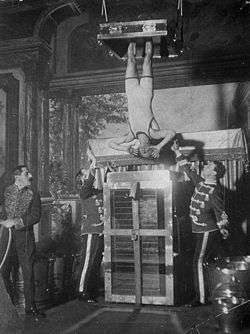
Around 1912, the vast number of imitators prompted Houdini to replace his milk can act with the Chinese water torture cell. In this escape, Houdini's feet were locked in stocks, and he was lowered upside down into a tank filled with water. The mahogany and metal cell featured a glass front, through which audiences could clearly see Houdini. The stocks were locked to the top of the cell, and a curtain concealed his escape. In the earliest version of the torture cell, a metal cage was lowered into the cell, and Houdini was enclosed inside that. While making the escape more difficult – the cage prevented Houdini from turning – the cage bars also offered protection should the front glass break. The original cell was built in England, where Houdini first performed the escape for an audience of one person as part of a one-act play he called "Houdini Upside Down". This was so he could copyright the effect and have grounds to sue imitators, which he did. While the escape was advertised as "The Chinese Water Torture Cell" or "The Water Torture Cell", Houdini always referred to it as "the Upside Down" or "USD". The first public performance of the USD was at the Circus Busch in Berlin, on September 21, 1912. Houdini continued to perform the escape until his death in 1926.[28]
Suspended straitjacket escape
One of Houdini's most popular publicity stunts was to have himself strapped into a regulation straitjacket and suspended by his ankles from a tall building or crane. Houdini would then make his escape in full view of the assembled crowd. In many cases, Houdini drew tens of thousands of onlookers who brought city traffic to a halt. Houdini would sometimes ensure press coverage by performing the escape from the office building of a local newspaper. In New York City, Houdini performed the suspended straitjacket escape from a crane being used to build the subway. After flinging his body in the air, he escaped from the straitjacket. Starting from when he was hoisted up in the air by the crane, to when the straitjacket was completely off, it took him two minutes and thirty-seven seconds. There is film footage in the Library of Congress of Houdini performing the escape.[51] Films of his escapes are also shown at The Houdini Museum in Scranton, Pennsylvania. After being battered against a building in high winds during one escape, Houdini performed the escape with a visible safety wire on his ankle so that he could be pulled away from the building if necessary. The idea for the upside-down escape was given to Houdini by a young boy named Randolph Osborne Douglas (March 31, 1895 – December 5, 1956), when the two met at a performance at Sheffield's Empire Theatre.[28]
Overboard box escape

Another of Houdini's most famous publicity stunts was to escape from a nailed and roped packing crate after it had been lowered into water. He first performed the escape in New York's East River on July 7, 1912. Police forbade him from using one of the piers, so he hired a tugboat and invited press on board. Houdini was locked in handcuffs and leg-irons, then nailed into the crate which was roped and weighed down with two hundred pounds of lead. The crate was then lowered into the water. He escaped in 57 seconds. The crate was pulled to the surface and found still to be intact, with the manacles inside.
Houdini performed this escape many times, and even performed a version on stage, first at Hamerstein's Roof Garden where a 5,500-US-gallon (21,000 l) tank was specially built, and later at the New York Hippodrome.[52]
Buried alive stunt
Houdini performed at least three variations on a buried alive stunt during his career. The first was near Santa Ana, California in 1915, and it almost cost Houdini his life. Houdini was buried, without a casket, in a pit of earth six feet deep. He became exhausted and panicked while trying to dig his way to the surface and called for help. When his hand finally broke the surface, he fell unconscious and had to be pulled from the grave by his assistants. Houdini wrote in his diary that the escape was "very dangerous" and that "the weight of the earth is killing".[53][54]
Houdini's second variation on buried alive was an endurance test designed to expose mystical Egyptian performer Rahman Bey, who had claimed to use supernatural powers to remain in a sealed casket for an hour. Houdini bettered Bey on August 5, 1926, by remaining in a sealed casket, or coffin, submerged in the swimming pool of New York's Hotel Shelton for one and a half hours. Houdini claimed he did not use any trickery or supernatural powers to accomplish this feat, just controlled breathing.[55] He repeated the feat at the YMCA in Worcester, Massachusetts on September 28, 1926, this time remaining sealed for one hour and eleven minutes.[56]
Houdini's final buried alive was an elaborate stage escape that featured in his full evening show. Houdini would escape after being strapped in a straitjacket, sealed in a casket, and then buried in a large tank filled with sand. While posters advertising the escape exist (playing off the Bey challenge by boasting "Egyptian Fakirs Outdone!"), it is unclear whether Houdini ever performed buried alive on stage. The stunt was to be the feature escape of his 1927 season, but Houdini died on October 31, 1926. The bronze casket Houdini created for buried alive was used to transport Houdini's body from Detroit to New York following his death on Halloween.[57]
Movie career
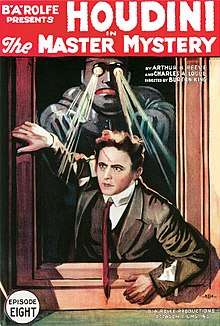
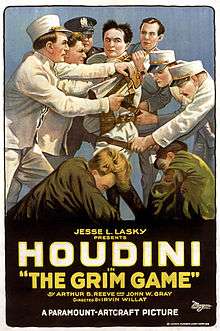
In 1906, Houdini started showing films of his outside escapes as part of his vaudeville act. In Boston, he presented a short film called Houdini Defeats Hackenschmidt. Georg Hackenschmidt was a famous wrestler of the day, but the nature of their contest is unknown as the film is lost.[58] In 1909, Houdini made a film in Paris for Cinema Lux titled Merveilleux Exploits du Célébre Houdini à Paris (Marvellous Exploits of the Famous Houdini in Paris).[59] It featured a loose narrative designed to showcase several of Houdini's famous escapes, including his straitjacket and underwater handcuff escapes. That same year Houdini got an offer to star as Captain Nemo in a silent version of 20,000 Leagues Under the Sea, but the project never made it into production.[60] It is often erroneously reported that Houdini served as special-effects consultant on the Wharton/International cliffhanger serial, The Mysteries of Myra, shot in Ithaca, New York, because Harry Grossman, director of The Master Mystery also filmed a serial in Ithaca at about the same time. The consultants on the serial were pioneering Hereward Carrington and Aleister Crowley.[61]
In 1918, Houdini signed a contract with film producer B. A. Rolfe to star in a 15-part serial, The Master Mystery (released in November 1918). As was common at the time, the film serial was released simultaneously with a novel. Financial difficulties resulted in B. A. Rolfe Productions going out of business, but The Master Mystery led to Houdini being signed by Famous Players-Lasky Corporation/Paramount Pictures, for whom he made two pictures, The Grim Game (1919) and Terror Island (1920).[62]
The Grim Game was Houdini's first full-length movie and is reputed to be his best. Because of the flammable nature of nitrate film and their low rate of survival, film historians considered the film lost. One copy did exist hidden in the collection of a private collector only known to a tiny group of magicians that saw it. Dick Brookz and Dorothy Dietrich of The Houdini Museum in Scranton, Pennsylvania had seen it twice on the invitation of the collector. After many years of trying, they finally got him to agree to sell the film to Turner Classic Movies[63] who restored the complete 71-minute film. The film, not seen by the general public for 96 years was shown by TCM on March 29, 2015, as a highlight of their yearly 4-day festival in Hollywood.[64]
While filming an aerial stunt for The Grim Game, two biplanes collided in mid-air with a stuntman doubling Houdini dangling by a rope from one of the planes. Publicity was geared heavily toward promoting this dramatic "caught on film" moment, claiming it was Houdini himself dangling from the plane. While filming these movies in Los Angeles, Houdini rented a home in Laurel Canyon. Following his two-picture stint in Hollywood, Houdini returned to New York and started his own film production company called the "Houdini Picture Corporation". He produced and starred in two films, The Man from Beyond (1921) and Haldane of the Secret Service (1923). He also founded his own film laboratory business called The Film Development Corporation (FDC), gambling on a new process for developing motion picture film. Houdini's brother, Theodore Hardeen, left his own career as a magician and escape artist to run the company. Magician Harry Kellar was a major investor.[65]
Neither Houdini's acting career nor FDC found success, and he gave up on the movie business in 1923, complaining that "the profits are too meager".
In April 2008, Kino International released a DVD box set of Houdini's surviving silent films, including The Master Mystery, Terror Island, The Man From Beyond, Haldane of the Secret Service, and five minutes from The Grim Game. The set also includes newsreel footage of Houdini's escapes from 1907 to 1923, and a section from Merveilleux Exploits du Célébre Houdini à Paris, although it is not identified as such.[66]
Aviator
In 1909, Houdini became fascinated with aviation. He purchased a French Voisin biplane for $5,000 and hired a full-time mechanic, Antonio Brassac. After crashing once, he made his first successful flight on November 26 in Hamburg, Germany. The following year, Houdini toured Australia. He brought along his Voisin biplane with the intention to be the first person in Australia to fly.
Falsely reported as pioneer
On March 18, 1910, he made three flights at Diggers Rest, Victoria, near Melbourne. It was reported at the time that this was the first aerial flight in Australia,[67][68][69] and a century later, some major news outlets still credit him with this feat.[70][71]
Wing Commander Harry Cobby wrote in Aircraft in March 1938 that "the first aeroplane flight in the Southern Hemisphere was made on December 9, 1909 by Mr Colin Defries, a Londoner, at Victoria Park Racecourse, Sydney, in a Wilbur Wright aeroplane".[72] Colin Defries was a trained pilot, having learnt to fly in Cannes, France. By modern standards his flight time was minimal, but in 1909 he had accumulated enough to become an instructor. On his first flight he took off, maintained straight and level flight, albeit briefly, and landed safely. His crash landing on his second flight, when he tried to retrieve his hat which was blown off, demonstrated what a momentary lack of attention could cause while flying a Wright Model A.
It is accepted by Australian historians[73] and the Aviation Historical Society of Australia that the definition of flight established by the Gorell Committee on behalf of the Aero Club of Great Britain dictates the acceptance of a flight or its rejection, giving Colin Defries credit as the first to make an aeroplane flight in Australia, and the Southern Hemisphere.
Additionally, aviation pioneer Richard Pearse is believed by many New Zealand historians to have undertaken his first flight as early as 1902, which would give him not only the Southern Hemisphere but the World record, although this is disputed.[74]
In 1965, aviation journalist Stanley Brogden formed the view that the first powered flight in Australia took place at Bolivar in South Australia; the aircraft was a Bleriot monoplane with Fred Custance as the pilot. The flight took place on March 17, 1910. The next day when Houdini took to the air, the Herald newspaper reported Custance's flight, stating it had lasted 5 minutes 25 seconds at a height of between 12 and 15 feet.[68]
In 2010, Australia Post issued stamps commemorating Colin Defries, Houdini and John Robertson Duigan, crediting only Defries and Duigan with historical firsts.[75] Duigan was an Australian pioneer aviator who built and flew the first Australian-made aircraft. Australia Post did acknowledge the part Houdini played (Harry Houdini can't escape being part of Australia's history) but did not attribute any record to him.
After Australia
After completing his Australia tour, Houdini put the Voisin into storage in England. He announced he would use it to fly from city to city during his next Music Hall tour, and even promised to leap from it handcuffed, but he never flew again.[76]
Debunking spiritualists
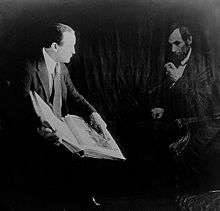
In the 1920s, Houdini turned his energies toward debunking psychics and mediums, a pursuit that inspired and was followed by latter-day stage magicians.[78]
Houdini's training in magic allowed him to expose frauds who had successfully fooled many scientists and academics. He was a member of a Scientific American committee that offered a cash prize to any medium who could successfully demonstrate supernatural abilities. None was able to do so, and the prize was never collected. The first to be tested was medium George Valiantine of Wilkes Barre, Pennsylvania. As his fame as a "ghostbuster" grew, Houdini took to attending séances in disguise, accompanied by a reporter and police officer. Possibly the most famous medium whom he debunked was Mina Crandon, also known as "Margery".[79]
Joaquín Argamasilla known as the "Spaniard with X-ray Eyes" claimed to be able to read handwriting or numbers on dice through closed metal boxes. In 1924, he was exposed by Houdini as a fraud. Argamasilla peeked through his simple blindfold and lifted up the edge of the box so he could look inside it without others noticing.[80] Houdini also investigated the Italian medium Nino Pecoraro, whom he considered to be fraudulent.[81]
Houdini's exposing of phony mediums has inspired other magicians to follow suit, including The Amazing Randi, Dorothy Dietrich, Penn & Teller, and Dick Brookz.[82]
Houdini chronicled his debunking exploits in his book, A Magician Among the Spirits, co-authored with C. M. Eddy, Jr., who was not credited. These activities cost Houdini the friendship of Sir Arthur Conan Doyle. Doyle, a firm believer in spiritualism during his later years, refused to believe any of Houdini's exposés. Doyle came to believe that Houdini was a powerful spiritualist medium, and had performed many of his stunts by means of paranormal abilities and was using these abilities to block those of other mediums that he was "debunking".[83] This disagreement led to the two men becoming public antagonists and Sir Arthur came to view Houdini as a dangerous enemy.[28]
Before Houdini died, he and his wife agreed that if Houdini found it possible to communicate after death, he would communicate the message "Rosabelle believe", a secret code which they agreed to use. Rosabelle was their favorite song. Bess held yearly séances on Halloween for ten years after Houdini's death. She did claim to have contact through Arthur Ford in 1929 when Ford conveyed the secret code, but Bess later said the incident had been faked. The code seems to have been such that it could be broken by Ford or his associates using existing clues.[28] Evidence to this effect was discovered by Ford's biographer after he died in 1971.[84] In 1936, after a last unsuccessful séance on the roof of the Knickerbocker Hotel, she put out the candle that she had kept burning beside a photograph of Houdini since his death. In 1943, Bess said that "ten years is long enough to wait for any man."
The tradition of holding a séance for Houdini continues, held by magicians throughout the world. The Official Houdini Séance was organized in the 1940s[85] by Sidney Hollis Radner, a Houdini aficionado from Holyoke, Massachusetts.[86] Yearly Houdini séances are also conducted in Chicago at the Excalibur nightclub by "necromancer" Neil Tobin on behalf of the Chicago Assembly of the Society of American Magicians;[87] and at the Houdini Museum in Scranton by magician Dorothy Dietrich, who previously held them at New York's Magic Towne House with such magical notables as Houdini biographers Walter B. Gibson and Milbourne Christopher. Gibson was asked by Bess Houdini to carry on the original seance tradition. After doing them for many years at New York's Magic Towne House, before he died, Walter passed on the tradition of conducting of the Original Seances to Dorothy Dietrich.[82]
In 1926, Harry Houdini hired H. P. Lovecraft and his friend C. M. Eddy, Jr., to write an entire book about debunking religious miracles, which was to be called The Cancer of Superstition. Houdini had earlier asked Lovecraft to write an article about astrology, for which he paid $75. The article does not survive. Lovecraft's detailed synopsis for Cancer does survive, as do three chapters of the treatise written by Eddy. Houdini's death derailed the plans, as his widow did not wish to pursue the project.[88]
Appearance and voice recordings
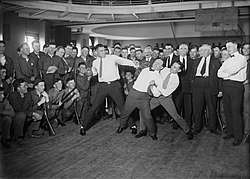
Unlike the image of the classic magician, Houdini was short and stocky and typically appeared on stage in a long frock coat and tie. Most biographers give his height as 5 feet 5 inches (1.65 m), but descriptions vary. Houdini was also said to be slightly bow-legged, which aided in his ability to gain slack during his rope escapes. In the 1997 biography Houdini!!!: The Career of Ehrich Weiss, author Kenneth Silverman summarizes how reporters described Houdini's appearance during his early career:
They stressed his smallness—"somewhat undersized"—and angular, vivid features: "He is smooth-shaven with a keen, sharp-chinned, sharp-cheekboned face, bright blue eyes and thick, curly, black hair." Some sensed how much his complexly expressive smile was the outlet of his charismatic stage presence. It communicated to audiences at once warm amiability, pleasure in performing, and, more subtly, imperious self-assurance. Several reporters tried to capture the charming effect, describing him as "happy-looking", "pleasant-faced", "good natured at all times", "the young Hungarian magician with the pleasant smile and easy confidence".[89]
Houdini made the only known recordings of his voice on Edison wax cylinders on October 29, 1914, in Flatbush, New York. On them, Houdini practices several different introductory speeches for his famous Chinese Water Torture Cell. He also invites his sister, Gladys, to recite a poem. Houdini then recites the same poem in German. The six wax cylinders were discovered in the collection of magician John Mulholland after his death in 1970. They are part of the David Copperfield collection.[90]
Personal life
Houdini became an active Freemason and was a member of St. Cecile Lodge No. 568 in New York City.[91]
In 1904, Houdini bought a New York City townhouse at 278 West 113th Street in Harlem. He paid US$25,000 for the five-level, 6,008-square-foot house, which was built in 1895, and lived in it with his wife Bess, and various other relatives until his death in 1926. In March 2018, it was purchased for $3.6 million. A plaque affixed to the building by the Historical Landmark Preservation Center reads, "The magician lived here from 1904 to 1926 collecting illusions, theatrical memorabilia, and books on psychic phenomena and magic."[92]
In 1918, he registered for selective service as Harry Handcuff Houdini.[93]
Death
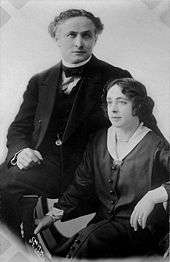
Harry Houdini died of peritonitis, secondary to a ruptured appendix, at 1:26 p.m. on October 31, 1926, in Room 401 at Detroit's Grace Hospital, aged 52. In his final days, he believed that he would recover, but his last words before dying were reportedly, "I'm tired of fighting... I do not want to fight anymore..."[28]
Witnesses to an incident at Houdini's dressing room in the Princess Theatre in Montreal speculated that Houdini's death was caused by a McGill University student, Jocelyn Gordon Whitehead (b. 1895 – d. 1954), who repeatedly struck Houdini's abdomen.[94]
The accounts of the witnesses, students named Jacques Price and Sam Smilovitz (sometimes called Jack Price and Sam Smiley), generally corroborated one another. Price said that Whitehead asked Houdini "if he believed in the miracles of the Bible" and "whether it was true that punches in the stomach did not hurt him". Houdini offered a casual reply that his stomach could endure a lot. Whitehead then delivered "some very hammer-like blows below the belt". Houdini was reclining on a couch at the time, having broken his ankle while performing several days earlier. Price said that Houdini winced at each blow and stopped Whitehead suddenly in the midst of a punch, gesturing that he had had enough, and adding that he had had no opportunity to prepare himself against the blows, as he did not expect Whitehead to strike him so suddenly and forcefully. Had his ankle not been broken, he would have risen from the couch into a better position to brace himself.[94][95]
Throughout the evening, Houdini performed in great pain. He was unable to sleep and remained in constant pain for the next two days, but did not seek medical help. When he finally saw a doctor, he was found to have a fever of 102 °F (39 °C) and acute appendicitis, and was advised to have immediate surgery. He ignored the advice and decided to go on with the show.[96][97] When Houdini arrived at the Garrick Theater in Detroit, Michigan, on October 24, 1926, for what would be his last performance, he had a fever of 104 °F (40 °C). Despite the diagnosis, Houdini took the stage. He was reported to have passed out during the show, but was revived and continued. Afterwards, he was hospitalized at Detroit's Grace Hospital.[94]
It is unclear whether the dressing room incident caused Houdini's eventual death, as the relationship between blunt trauma and appendicitis is uncertain.[94] One theory suggests that Houdini was unaware that he was suffering from appendicitis, and might have been aware had he not received blows to the abdomen.[94]
After taking statements from Price and Smilovitz, Houdini's insurance company concluded that the death was due to the dressing-room incident and paid double indemnity.[96]
Houdini grave site
Houdini's funeral was held on November 4, 1926, in New York City, with more than 2,000 mourners in attendance.[98] He was interred in the Machpelah Cemetery in Glendale, Queens, with the crest of the Society of American Magicians inscribed on his grave site. A statuary bust was added to the exedra in 1927, a rarity, because graven images are forbidden in Jewish cemeteries. In 1975, the bust was destroyed by vandals. Temporary busts were placed at the grave until 2011 when a group who came to be called The Houdini Commandos from the Houdini Museum in Scranton, Pennsylvania placed a permanent bust with the permission of Houdini's family and of the cemetery.[99] The Society of American Magicians took responsibility for the upkeep of the site, as Houdini had willed a large sum of money to the organization he had grown from one club to 5,000–6,000 dues-paying membership worldwide. The payment of upkeep was abandoned by the society's dean George Schindler, who said "Houdini paid for perpetual care, but there's nobody at the cemetery to provide it", adding that the operator of the cemetery, David Jacobson, "sends us a bill for upkeep every year but we never pay it because he never provides any care." Members of the Society tidy the grave themselves.[100]
Machpelah Cemetery operator Jacobson said, they "never paid the cemetery for any restoration of the Houdini family plot in my tenure since 1988", claiming that the money came from the cemetery's dwindling funds. The granite monuments of Houdini's sister, Gladys, and brother, Leopold were also destroyed by vandals.[101] For many years, until recently, the Houdini grave site has been only cared for by Dorothy Dietrich and Dick Brookz of the Houdini Museum in Scranton, Pennsylvania.[102] The Society of American Magicians, at its National Council Meeting in Boca Raton, Florida, in 2013, under the prompting of The Houdini Museum's Dorothy Dietrich and Dick Brookz, voted to assume the financial responsibilities for the care and maintenance of the Houdini Gravesite. In MUM Magazine, the Society's official magazine, President Dal Sanders announced "Harry Houdini is an icon as revered as Elvis Presley or Marilyn Monroe. He is not only a magical icon; his gravesite bears the seal of The Society of American Magicians. That seal is our brand and we should be proud to protect it. This gravesite is clearly our responsibility and I'm proud to report that the National Council unanimously voted to maintain Houdini's final resting place."[103]
The Houdini Gravesite Restoration Committee under the Chairmanship of National President David Bowers, is working closely with National President Kenrick "Ice" McDonald to see this project to completion. Bowers said it is a foregone conclusion that the Society will approve the funding request, because "Houdini is responsible for the Society of American Magicians being what it is today. We owe a debt of gratitude to him." Like Bowers, McDonald said the motivation behind the repairs is to properly honor the grave of the "Babe Ruth of magicians". "This is hallowed ground," he said. "When you ask people about magicians, the first thing they say is Harry Houdini." While the actual plot will remain under the control of Machpelah Cemetery management, the Society of American Magicians, with the help of the Houdini Museum in Pennsylvania, will be in charge of the restoration.[104]
Magicians Dorothy Dietrich and Dick Brookz have been caring for the escape artist's Queens grave over the years. "This is a monument where people go and visit on a daily basis," said Dietrich who is spearheading restoration efforts. "The nearly 80-year-old popular plot at the Machpelah Cemetery has fallen into disrepair over the years." "The Houdini Museum has teamed with The Society of American Magicians, one of the oldest fraternal magic organizations in the world, to give the beloved site a facelift." The organization has a specific Houdini gravesite committee made up of nine members headed up by President elect David Bowers who brought this project to the Society's attention. Kenrick "Ice" McDonald, the current president of the Society of American Magicians said "You have to know the history. Houdini served as President from 1917 until his death in 1926. Houdini's burial site needs an infusion of cash to restore it to its former glory." Magician Dietrich said the repairs could cost "tens of thousands of dollars", after consulting with glass experts and grave artisans. "It's a wonderful project, but it's taken a lifetime to get people interested," she said. "It's long overdue, and it's great that it's happening." Houdini was a living superhero," Dietrich said. "He wasn't just a magician and escape artist, he was a great humanitarian." To this day, the Society holds a broken wand ceremony at the grave every November.
Houdini's widow, Bess, died of a heart attack on February 11, 1943, aged 67, in Needles, California while on a train en route from Los Angeles to New York City. She had expressed a wish to be buried next to her husband, but instead was interred 35 miles due north at the Gate of Heaven Cemetery in Westchester County, New York, as her Catholic family refused to allow her to be buried in a Jewish cemetery.[105]
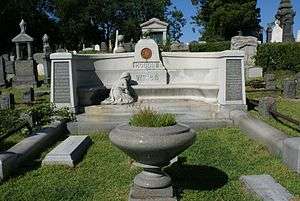
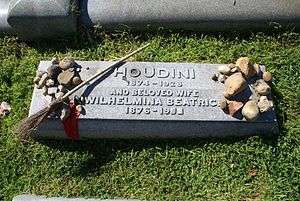
Proposed exhumation
On March 22, 2007, Houdini's grand-nephew (the grandson of his brother Theo), George Hardeen, announced that the courts would be asked to allow exhumation of Houdini's body, to investigate the possibility of Houdini being murdered by spiritualists, as suggested in the biography The Secret Life of Houdini.[106] In a statement given to the Houdini Museum in Scranton, the family of Bess Houdini opposed the application and suggested it was a publicity ploy for the book.[107] The Washington Post stated that the press conference was not arranged by the family of Houdini. Instead, the Post reported, it was orchestrated by authors Kalush and Sloman, who hired the PR firm Dan Klores Communications to promote their book.[108]
In 2008, it was revealed the parties involved never filed legal papers to perform an exhumation.[109]
Legacy
Houdini's brother, Theodore Hardeen, who returned to performing after Houdini's death, inherited his brother's effects and props. Houdini's will stipulated that all the effects should be "burned and destroyed" upon Hardeen's death. Hardeen sold much of the collection to magician and Houdini enthusiast Sidney Hollis Radner during the 1940s, including the water torture cell.[110] Radner allowed choice pieces of the collection to be displayed at The Houdini Magical Hall of Fame in Niagara Falls, Ontario. In 1995, a fire destroyed the museum. The water torture cell's metal frame remained, and it was restored by illusion builder John Gaughan.[111] Many of the props contained in the museum such as the mirror handcuffs, Houdini's original packing crate, a milk can, and a straitjacket, survived the fire and were auctioned in 1999 and 2008.
Radner loaned the bulk of his collection for archiving to the Outagamie Museum in Appleton, Wisconsin but reclaimed it in 2003 and auctioned it in Las Vegas, on October 30, 2004.[112]
Houdini was a "formidable collector", and bequeathed many of his holdings and paper archives on magic and spiritualism to the Library of Congress, which became the basis for the Houdini collection in cyberspace.[113]
In 1934, the bulk of Houdini's collection of American and British theatrical material, along with a significant portion of his business and personal papers, and some of his collections of other magicians were sold to pay off estate debts to theatre magnate Messmore Kendall. In 1958, Kendall donated his collection to the Hoblitzelle Theatre Library at the University of Texas at Austin.[114] In the 1960s, the Hoblitzelle Library became part of the Harry Ransom Center. The extensive Houdini collection includes a 1584 first edition of Reginald Scot's Discoverie of Witchcraft and David Garrick's travel diary to Paris from 1751.[115][116] Some of the scrapbooks in the Houdini collection have been digitized.[117] The collection was exclusively paper-based until April 2016, when the Ransom Center acquired one of Houdini's ball weights with chain and ankle cuff. In October 2016, in conjunction with the 90th anniversary of the death of Houdini, the Ransom Center embarked on a major re-cataloging of the Houdini collection to make it more visible and accessible to researchers.[118] The collection reopened in 2018, with its finding aids posted online.[119]
A large portion of Houdini's estate holdings and memorabilia was willed to his fellow magician and friend, John Mulholland (1898–1970). In 1991, illusionist and television performer David Copperfield purchased all of Mulholland's Houdini holdings from Mulholland's estate. These are now archived and preserved in Copperfield's warehouse at his headquarters in Las Vegas. It contains the world's largest collection of Houdini memorabilia, and preserves approximately 80,000 items of memorabilia of Houdini and other magicians, including Houdini's stage props and material, his rebuilt water torture cabinet and his metamorphosis trunk. It is not open to the public, but tours are available by invitation to magicians, scholars, researchers, journalists and serious collectors.
In a posthumous ceremony on October 31, 1975, Houdini was given a star on the Hollywood Walk of Fame at 7001 Hollywood Blvd.[120]
The Houdini Museum in Scranton, Pennsylvania, bills itself as "the only building in the world entirely dedicated to Houdini". It is open to the public year-round by reservation. It includes Houdini films, a guided tour about Houdini's life and a stage magic show. Magicians Dorothy Dietrich and Dick Brookz opened the facility in 1991.
The Magic Castle in Los Angeles, California, a nightclub for magicians and magic enthusiasts, as well as the clubhouse for the Academy of Magical Arts, features Houdini séances performed by magician Misty Lee.
The House of Houdini is a museum and performance venue located at 11, Dísz square in the Buda Castle in Budapest, Hungary. It claims to house the largest collection of original Houdini artifacts in Europe.[121]
The Houdini Museum of New York is located at Fantasma Magic, a retail magic manufacturer and seller located in Manhattan. The museum contains several hundred pieces of ephemera, most of which belonged to Harry Houdini.
In popular culture
- Houdini appeared as himself in Weird Tales magazine in three ghostwritten fictionalizations of sensational events from his career (issues of March, April, and May–June–July 1924). The third story, "Imprisoned with the Pharaohs," was written by horror writer H. P. Lovecraft based on Houdini's notes. The Houdini-Lovecraft collaboration was envisioned to continue, but the magazine ceased publication for financial reasons. When it resumed later in 1924, Houdini no longer figured in its plans.[122]
- Houdini (1953)—played by Tony Curtis
- The Great Houdini a.k.a. The Great Houdinis (1976)—played by Paul Michael Glaser (TV movie)
- Ragtime (1981)—played by Jeffrey DeMunn, based on the novel by E. L. Doctorow, in which he plays a major role. Jim Corti played him in the original Broadway production of the musical based on the same novel.
- Houdini is the subject of the song "Houdini" on the 1982 album The Dreaming by Kate Bush. The album's cover art, in which Bush is depicted holding a key in her mouth and bending in to kiss a chained figure whose face is turned away from the camera, is an homage to Bess Houdini.
- Young Harry Houdini (1987)—played by Wil Wheaton & Jeffrey DeMunn (TV movie)
- A Night at the Magic Castle (1988)—played by Arte Johnson
- Canadian synth-pop duo Kon Kan released the song "Harry Houdini" in 1989.
- FairyTale: A True Story (1997)—played by Harvey Keitel
- Houdini (1998)—played by Johnathon Schaech (TV movie)
- Cremaster 2 (1999)—played by Norman Mailer
- Death Defying Acts (2007)—played by Guy Pearce
- Murdoch Mysteries (2008)—played by Joe Dinicol (TV series)
- Houdini (2014)—played by Adrien Brody (TV miniseries)[123]
- Houdini and Doyle (2016)—played by Michael Weston (TV series)
- Timeless (2016)—played by Michael Drayer (TV series)
- d'ILLUSION: The Houdini Musical - The Audio Theater Experience (2020)—played by Julian R. Decker (Audiobook) [124][125][126]
Publications
Houdini published numerous books during his career (some of which were written by his good friend Walter B. Gibson, the creator of The Shadow)[127]
- The Right Way to Do Wrong: An Exposé of Successful Criminals (1906)
- Handcuff Secrets (1907)
- The Unmasking of Robert-Houdin (1908), a debunking study of Robert-Houdin's alleged abilities.
- Magical Rope Ties and Escapes (1920)
- Miracle Mongers and Their Methods (1920)
- Houdini's Paper Magic (1921)
- A Magician Among the Spirits (1924)
- Houdini Exposes the Tricks Used by the Boston Medium "Margery" (1924)
- Imprisoned with the Pharaohs (1924), a short story ghostwritten by H. P. Lovecraft.
- How I Unmask the Spirit Fakers, article for Popular Science (November 1925)
- How I do My "Spirit Tricks", article for Popular Science (December 1925)
- Conjuring (1926), article for the Encyclopædia Britannica's 13th edition.
Filmography
- Merveilleux Exploits du Célébre Houdini à Paris—Cinema Lux (1909)—playing himself
- The Master Mystery—Octagon Films (1918)—playing Quentin Locke
- The Grim Game—Famous Players-Lasky/Paramount Pictures (1919)—playing Harvey Handford
- Terror Island—Famous Players Lasky/Paramount (1920)—playing Harry Harper
- The Man from Beyond—Houdini Picture Corporation (1922)—playing Howard Hillary
- Haldane of the Secret Service—Houdini Picture Corporation/FBO (1923)—playing Heath Haldane
See also
- Illusionist
- List of magic museums
- List of magicians
- Swami Laura Horos
- Walford Bodie—A friend of Houdini, and fellow magician
References
- Schiller, Gerald. (2010). It Happened in Hollywood: Remarkable Events That Shaped History. Globe Pequot Press. p. 34. ISBN 978-0-7627-5449-6
- "Harry Houdini". Encyclopædia Britannica. Retrieved March 24, 2014.
- "137 years ago in Budapest ..." Wild About Harry. Retrieved March 24, 2011.
- "Hardeen Dead, 69. Houdini's Brother. Illusionist, Escape Artist, a Founder of Magician's Guild. Gave Last Show May 29". The New York Times. June 13, 1945. Retrieved March 24, 2020.
Theodore Hardeen, a brother of the late Harry Houdini, illusionist and a prominent magician in his own right, died yesterday in the Doctors Hospital. His age was 69.
- Meyer, Bernard C. (1976), Houdini: A Mind in Chains, E.P. Dutton & Co., Chapter 1, p. 5, ISBN 0-8415-0448-2.
- "The mystery of Carrie Gladys Weiss". Wild About Harry. Retrieved September 30, 2011.
- US National Archives Microfilm serial: M237; Microfilm roll: 413; Line: 38; List number: 684.
- 1880 US Census with Samuel M. Weiss, Cecelia (wife), Armin M., Nathan J., Ehrich, Theodore, and Leopold.
- Houdini's Forgotten Years The Houdini File.
- "Harry Houdini" (PDF). American Decades. December 16, 1998. Retrieved February 4, 2016. Also at Biography In Context.
- Loxton, Daniel (January 30, 2013). "The Remarkable Mr. Rinn". Skeptic Magazine. Retrieved January 16, 2016.
- Rocha, Guy. "MYTH No. 56 – No Disappearing Act for Harry Houdini at Piper's Opera House". Nevada State Library and Archives. Archived from the original on July 22, 2011. Retrieved March 24, 2011.
- Immerso, Michael. (2002). Coney Island: The People's Playground. Rutgers University Press. p. 114. ISBN 978-0813531380
- "Harry Houdini: Famous magician, master of escapes, Houdini metamorphosis". Houdini Magic. Retrieved February 4, 2016.
- Houdini, King of Cards The Houdini Files.
- Johnson, Karl (2005). The Magician and the Cardsharp.
- Gresham, William Lindsay. (1959). Houdini: The Man Who Walked Through Walls. Holt. pp. 82–83
- Price, David. (1985). Magic: A Pictorial History of Conjurers in the Theater. Cornwall Books. p. 191. ISBN 0-8453-4738-1
- Tait,Derek. (2017). The Great Houdini: His British Tours (Kindle Edition). Pen&Sword Books Ltd. Chapter One ISBN 978-1-47386-794-9
- Silverman, p. 81.
- Silverman, p. 109.
- Steinmeyer, Jim. (2004). Hiding The Elephant: How Magicians Invented the Impossible. Da Capo Press. pp. 152–153. ISBN 0-7867-1401-8
- Jones, Graham Matthew. (2007). Trades of the Trick: Conjuring Culture in Modern France. New York University. pp. 96–98
- Gresham, William Lindsay (1959). Houdini: The Man Who Walked Through Walls. Holt. p. 136
- Steinmeyer, Jim. (2006). The Glorious Deception: The Double Life of William Robinson, Aka Chung Ling Soo, the Marvelous Chinese Conjurer. Da Capo Press. p. 291. ISBN 0-78671-770-X
- Cannell, J. C. (1973). The Secrets of Houdini. New York: Dover Publications. pp. 36–41. ISBN 978-0486229133. Retrieved August 17, 2012.
- "Houdini's escapes and magic – Houdini's unique challenges in Scranton, PA. during the vaudeville era". Retrieved September 29, 2014.
- Kalush, William; Sloman, Larry (October 2006). The Secret Life of Houdini: The Making of America's First Superhero. Simon & Schuster. ISBN 978-0-7432-7207-0. Retrieved November 9, 2015.
- Steinmeyer, Jim. (2004). Hiding The Elephant: How Magicians Invented the Impossible. Da Capo Press. pp. 154–155. ISBN 0-7867-1401-8 "He decided to portray Robert-Houdin as a liar and thief who was completely incompetent as a magician. Houdini had developed a hatred for his spiritual father. In 1908 his collection of articles was gathered together, expanded and sold to a London publisher. By comparing the original articles with the finished book, it's clear that Houdini employed a ghost writer to polish the language and clarify his points. Other surviving manuscripts from Houdini demonstrate that most of Houdini's writing depended on ghostwriters. The theme of his book on Robert-Houdin was sharpened to a razor's edge, and was now titled The Unmasking of Robert-Houdin."
- Goto-Jones, Chris. (2016). Conjuring Asia. Cambridge University Press. p. 193. ISBN 978-1-107-07659-4
- Inge, M. Thomas; Hall, Dennis. (2002). The Greenwood Guide to American Popular Culture, Volume 3. Greenwood Press. p. 1037. ISBN 978-0313323690 "Stung by the refusal of the widow of Robert-Houdin's son Emile to receive him in 1901, Houdini launched a literary vendetta against his former hero in the form of a book, The Unmasking of Robert-Houdin, published seven years later. While the book did not achieve its aim, it remains of considerable historical interest as the first sustained attempt to mine Houdini's large and growing collection for historical information. Its errors and oversights became the subject of two extensive rebuttals. The first was Maurice Sardina's Les Erreurs de Harry Houdini, translated and edited by Victor Farelli as Where Houdini Was Wrong. The second was Jean Hugard's Houdini's "Unmasking": Fact vs Fiction.
- Steinmeyer, Jim. (2004). Hiding The Elephant: How Magicians Invented the Impossible. Da Capo Press. p. 156. ISBN 0-7867-1401-8 "A number of researchers and authors have dismissed his claims and defended Robert-Houdin's reputation."
- Jones, Graham M. (2011). Trade of the Tricks: Inside the Magician's Craft. University of California Press. p. 208. ISBN 978-0-520-27046-6 "The publication ultimately did more to tarnish Houdini's reputation than to refute Robert-Houdin's claims to originality and distinction especially in France, where magicians rallied to defend their spiritual progenitor against aspersions cast by an American parvenu."
- "The Vanishing Elephant". Retrieved June 30, 2016.
- Christopher, Milbourne. (1990 edition, originally published in 1962). Magic: A Picture History. Dover Publications. p. 160. ISBN 0-486-26373-8 "Morritt invented a 'Disappearing Donkey'. When he expanded the idea so that an elephant could be whisked away in a box, Houdini bought the full rights to the spectacular illusion."
- Silverman, p. 224.
- Silverman, Kenneth (September 1996). Houdini! The Career of Ehrich Weiss: American Self-Liberator, Europe's Eclipsing Sensation, World's Handcuff King & Prison Breaker. HarperCollins. p. 544. ISBN 978-0060169787.
- John Cox (2017) [2011]. "Houdini: A Biography". Wild About Harry. Retrieved February 10, 2017.
- The Secret Life of Houdini, Kaulush & Sloman, 2006.
- Hanzlik, Mick (2007). "Houdini's Mirror Handcuff Challenge, Getting Closer to the Truth". Reproduction in full of Daily Mirror article "Houdini's Great Victory", March 18, 1904.
- Silverman, pp. 59–62.
- "Keys To Houdini's Secrets". Mysteries at the Museum. Travel Channel. November 23, 2010. Retrieved November 9, 2015.
- "Mirror Cuffs". Genii Magazine. Retrieved November 30, 2011.
- "Travel Channel Dorothy Dietrich Promo Houdini Mirror Cuffs". Mysteries at the Museum. Travel Channel. Retrieved November 29, 2011.
- Hanzlik, Mick (March 16, 2013). "The Replica Mirror Cuffs". Wild About Harry.
- Randi, pp. 175–178.
- Randi, Milk Can poster on page 177.
- Christopher, Milbourne (October 1976). Houdini: A Pictorial Life. Ty Crowell Co. p. 54. ISBN 978-0690011524.
- "American Museum of Magic". Marshall area Chamber of Commerce. Archived from the original on October 11, 2007. Retrieved April 20, 2008.
- Tait, Derek (2018). The Great Illusionists. Barnsley South, Yorkshire: Pen and Sword History. pp. 260–274. ISBN 978-1473890763.
- "Thousands see Harry Houdini escape from a straitjacket while hanging in mid-air, Chicago, Ill.", International news [1923 or 1924?]
- Henning, Doug (December 1, 1977). Houdini His Legend and His Magic. Times Books. ISBN 9780812906868.
- Christopher, Milbourne (1969). Houdini: The Untold Story. Ty Crowell Co. p. 140. ISBN 978-0891909811.
- "Digging into Houdini's Buried Alive". Retrieved January 6, 2011.
- Silverman, pp. 397–403.
- "Uncovering Houdini's second underwater test". Retrieved January 26, 2010.
- Silverman, p. 406.
- "Houdini Defeats Hackenschmidt and other revelations from Disappearing Tricks". Retrieved January 31, 2010.
- Disappearing Tricks by Matthew Solomon, 2010, p. 95.
- Silverman, p. 205.
- Stedman, Eric (2010). The Mysteries of Myra. p. 8.
- "Adroit Harry and ancient hokum". Retrieved December 30, 2012.
- "Turner Classic Movies to Host World Premiere Screening of Long Lost Harry Houdini Classic The Grim Game at 2015 TCM Classic Film Festival" (Press release). TCM. January 23, 2015. Archived from the original on January 2, 2016. Retrieved November 9, 2015.
- "Houdini Museum in Scranton PA Reveals the Secrets of Uncovering Houdini's 1919 Lost Silent Film The Grim Game". Retrieved January 23, 2015.
- Silverman, pp. 226–249.
- "Houdini The Movie Star DVD collection released". Retrieved April 8, 2008.
- "AERIAL FLIGHT IN AUSTRALIA". The Evening Post. LXXIX (66). Wellington. Press Association. March 19, 1910. Retrieved November 9, 2015.
- Prisk, Max (May 10, 2008). "Houdini's Australian dream: one for the record books". The Sydney Morning Herald. Retrieved November 9, 2015.
- "Australian National Aviation Museum – Early Australian Aviation". Aarg.com.au. Archived from the original on July 19, 2011. Retrieved April 1, 2011.
- "The Art and Magic of Harry Houdini". CBS News. November 2, 2010. Retrieved November 9, 2015.
- Entertainment Houdini's flight into history. Weekly Times Now (March 18, 2010). Retrieved February 28, 2012. Archived April 29, 2010, at the Wayback Machine
- While this was possibly the first flight in Australia, the first flight in the Southern Hemisphere was probably made by Richard Pearse in New Zealand several years earlier, either in 1903 or 1904.
- The Powerhouse Museum is the major branch of the Museum of Applied Arts and Sciences in Sydney. First Powered Flight in Australia- Episode 4 « Inside the collection – Powerhouse Museum. Powerhousemuseum.com. Retrieved February 28, 2012.
- "Richard Pearse". New Zealand History. Retrieved June 10, 2015.
- Australia Post – Harry Houdini can't escape being part of Australia's history. Auspost.com.au. Retrieved February 28, 2012. Archived September 10, 2011, at the Wayback Machine
- Silverman, pp. 137–154.
- "Notes to Houdini and the ghost of Abraham Lincoln". Library of Congress. Retrieved November 9, 2015.
- Jay, Ricky (March 3, 2011). "Conjuring". Encyclopædia Britannica. Retrieved November 9, 2015.
- ""Margery" the Medium Exposed". American Experience. PBS. 2011. Retrieved November 9, 2015.
- Nickell, Joe (2007). Adventures in Paranormal Investigation. University Press of Kentucky. pp. 213–215. ISBN 978-0-8131-2467-4
- Polidoro, Massimo. (2001). Final Séance: The Strange Friendship Between Houdini and Conan Doyle. Prometheus Books. pp. 127–128. ISBN 1-57392-896-8
- Williams, Michael (October 29, 2014). "Annual Houdini Séance to be held on Halloween". Tennessee Star Journal. Archived from the original on October 22, 2015. Retrieved November 9, 2015.
- see Conan Doyle's The Edge of The Unknown, published in 1931.
- Spragget, Allen; Rauscher, William V. (1974). Arthur Ford: The Man Who Talked with the Dead. New American Library. p. 246.
- Berthiaume, Ed (October 31, 2014). "Boldt CEO spends Halloween in search of Houdini". The Post-Crescent. Appleton, Wisconsin. Retrieved November 9, 2015.
- Houdini Facts .
- "Houdini's Halloween". WGN-TV and Red Eye. October 28, 2005. Archived from the original on March 10, 2007. Retrieved February 4, 2016.
- Joshi, S.T., ed. (May 31, 2005). Collected Essays of H. P. Lovecraft: Science. 3. New York: Hippocampus Press. pp. 11–12. ISBN 978-0974878980.
- Silverman, p. 31.
- "Houdini speaks in 1970". Retrieved November 13, 2010.
- "Famous Masons". MWGLNY. January 2014. Archived from the original on November 10, 2013.
- Gordon, Lisa Kaplan (March 27, 2018). "Harry Houdini's House Is About to Disappear from the Market". Town & Country. Archived from the original on October 30, 2019. Retrieved January 2, 2020.
- "Notable Registrants of the World War I Draft: Harry Houdini". National Archives and Records Administration. Retrieved November 9, 2015.
- Mikkelson, Barbara and David P. (September 2, 2014). "Punched Out". Snopes.com.
- Conan Doyle, Arthur (1930). Edge of the Unknown. ISBN 978-1409235149.
- Bell, Don (September 28, 2005). The Man Who Killed Houdini. Véhicule Press. ISBN 978-1550651874.
- Benoit, Tod (May 2003). Where Are They Buried? How Did They Die?. Black Dog & Leventhal Publishers. p. 469. ISBN 978-0739465585.
- Goldenberg, Suzanne (March 24, 2007). "Final Escape for the Master of Illusion? Houdini's Family Press for Exhumation". The Guardian. Retrieved November 9, 2015.
- Dunlap, David W. (October 24, 2011). "Houdini Returns". The New York Times. Retrieved October 24, 2011.
- Kilgannon, Corey (October 31, 2008). "Houdini's Final Trick, a Tidy Grave". The New York Times. Retrieved October 31, 2008.
- LeDuff, Charlie (November 24, 1996). "Houdinis' Plot Is Cleared Up, and Then Thickens". The New York Times. Retrieved June 10, 2015.
- Sanders, Dal (December 15, 2013). "From the President's Desk Dal Sanders" (PDF). MUM Magazine. Archived from the original (PDF) on November 5, 2014. Retrieved December 15, 2013.
- Barca, Christopher (October 9, 2014). "Houdini's grave to get a facelift". Queens Chronicle. Retrieved October 9, 2014.
- Rosenberg, Eli (October 27, 2014). "Houdini's gravesite to get a magic fix in Queens". Daily News. New York. Retrieved October 27, 2014.
- "Bess Houdini dies in 1943". Houdini.net. Retrieved April 1, 2011.
- "Grandnephew seeks to 'set record straight' about Houdini's death". CBC News. March 23, 2007. Retrieved March 23, 2007.
- "Family Statement re: exhumation". Retrieved March 26, 2007.
- Segal, David (March 24, 2007). "Why Not Just Hold a Seance?". The Washington Post. Retrieved March 24, 2007.
- "Time to bury the Houdini exhumation". Wild About Harry. Retrieved April 9, 2011.
- "With Sadness, Prime Houdini Artifact Collector Puts Items on Auction Block". The New York Times. October 29, 2004. Retrieved March 24, 2020.
... Mr. Radner, aka Rendar the Magician, owns one of the world's biggest and most valuable collections of Harry Houdini artifacts, including the Chinese Water Torture Cell, one of Houdini's signature props from 1912 until his death in 1926. Most of the items were given to Mr. Radner in the 1940s by Houdini's brother, Theodore Hardeen. Hardeen considered Radner, then a student at Yale with a reputation for jumping from diving boards in handcuffs, as his protégé. Until early this year, the collection was on display at the Outagamie Museum in Appleton, Wisconsin, where Houdini's father was the town rabbi in the 1870s. But after a rancorous falling out between Mr. Radner and museum officials, the 1,000-piece collection was packed-up and shipped here, where it will be auctioned on Saturday in the windowless back room at the Liberace Museum and on eBay.
- "The Mystery of the Two Torture Cells". Wild About Harry. Retrieved May 14, 2007.
- "Houdini's Magic Shop | Novelties". houdini.com. Archived from the original on May 15, 2006. Retrieved January 27, 2014.
- Higbee, Joan. "Great Escapes". American Memory Web Site, Hosts Houdini Collection. Library of Congress. Retrieved March 24, 2011.
- "The Performing Arts Collection". hrc.utexas.edu. Retrieved March 15, 2017.
- Scot, Reginald (January 1, 1584). The discouerie of witchcraft,: wherein the lewde dealings of witches and witchmongers is notablie detected, the knauerie of coniurors, the impietie of inchantors, thefollie of soothsaiers, the impudent falshood of cousenors, the infidelitie of atheists, the pestilent practices of Pythonists, the curiositie of figure casters, the vanitie of dreamers, the beggerlie art of alcumystrie, the abhomination of idolatrie, the horrible art of poisoning, the vertue and power of naturall magike, and all the conueiances of legierdemaine and iuggling are deciphered and many other things opened which have long lien hidden, howbeit verie necessarie to be knowne. Heerevnto is added a treatise vpon the nature and substance of spirits and diuels, &c. Imprinted at London: By William Brome.
- "Harry Ransom Center on Twitter". Twitter. Retrieved March 15, 2017.
- "Harry Houdini Scrapbook Collection". hrc.contentdm.oclc.org. Retrieved March 15, 2017.
- "Houdini: Illusionist and collector". Cultural Compass. Retrieved March 15, 2017.
- "Harry Houdini: An Inventory of His Papers at the Harry Ransom Center". norman.hrc.utexas.edu. Evanion, Henry, 1831?–1905., Hardeen, 1876–1945., Houdini, Beatrice, 1876–1943., Houdini, Harry, 1974-1926., Ingersoll, Robert Green, 1833–1899., Northcote, James, 1746–1831. Retrieved September 8, 2018.CS1 maint: others (link)
- "Harry Houdini". walkoffame.com. Hollywood Chamber of Commerce. Retrieved May 13, 2015.
Address: 7001 Hollywood Blvd. Ceremony: October 31, 1975.
- "House of Houdini Official website". The House of Houdini. Retrieved January 22, 2017.
- "The Magician's Ghostwriters" in The Thing's Incredible! The Secret Origins of Weird Tales (Off-Trail Publications, 2018).
- "IT'S ON! History greenlights Houdini miniseries". Wild About Harry. Retrieved August 19, 2013.
- "d'ILLUSION: The Houdini Musical - The Aduio Theater Experience". Retrieved August 3, 2020.
- Desk, BWW News. "D'ILLUSION: THE HOUDINI MUSICAL Announces Launch of Audiobook". BroadwayWorld.com.
- Desk, BWW News. "d'ILLUSION: The Houdini Musical Releases Theater Audio Experience". BroadwayWorld.com.
- "James Randi's Swift". randi.org. July 14, 2006.
Bibliography
- Brandon, Ruth (1993). The Life and Many Deaths of Harry Houdini. London: Secker & Warburg, Ltd. ISBN 978-0394224152.
- Fleischman, Sid (August 1, 2006). Escape! The Story of The Great Houdini. Greenwillow Books. ISBN 978-0-06-085094-4.
- Gresham, William Lindsay Houdini: The Man Who Walked Through Walls (New York: Henry Holt & Co., 1959).
- Henning, Doug with Charles Reynolds. Houdini: His Legend and His Magic (New York: Times Books, 1978). ISBN 978-0-446-87328-4.
- Kalush, William; Sloman, Larry (October 2006). The Secret Life of Houdini: The Making of America's First Superhero. New York: Simon & Schuster. ISBN 978-0-7432-7207-0.
- Kellock, Harold. Houdini: His Life-Story from the recollections and documents of Beatrice Houdini, (Harcourt, Brace Co., June 1928).
- Kendall, Lance. Houdini: Master of Escape (New York: Macrae Smith & Co., 1960). ISBN 0-06-092862-X.
- Meyer, M.D., Bernard C. Houdini: A Mind in Chains (New York: E. P. Dutton & Co., 1976). ISBN 0-8415-0448-2.
- Randi, James; Sugar, Bert Randolph (1977). Houdini: His Life and Art. New York City: Grosset & Dunlap. ISBN 978-0-448-12546-6.
- Silverman, Kenneth (1996). Houdini!!!: The Career of Ehrich Weiss : American Self-Liberator, Europe's Eclipsing Sensation, World's Handcuff King & Prison Breaker. New York: HarperCollins Publishers. ISBN 0-06-092862-X.
- Stanyon, Ellis (1901). Magic: Harry Houdini Collection. London: Ellis Stanyon.
- Williams, Beryl & Samuel Epstein. The Great Houdini: Magician Extraordinary (New York: Julian Messner, Inc., 1950).
Further reading
- "Who Is Houdini?" by Fred Lockley, Photoplay, June 1920, p. 50.
- "An Interview with Harry Houdini" by Marcet Haldeman-Julius, Haldeman-Julius Monthly Vol. 2.5 (October 1925), pp. 387–397.
- Houdini's Escapes and Magic by Walter B. Gibson, Prepared from Houdini's private notebooks Blue Ribbon Books, Inc., 1930. Reveals some of Houdini's magic and escape methods (also released in two separate volumes: Houdini's Magic and Houdini's Escapes).
- The Secrets of Houdini by J.C. Cannell, Hutchinson & Co., London, 1931. Reveals some of Houdini's escape methods.
- Houdini and Conan Doyle: The Story of a Strange Friendship by Bernard M. L. Ernst, Albert & Charles Boni, Inc., NY, 1932.
- Sixty Years of Psychical Research by Joseph Rinn, Truth Seeker Co., 1950, Rinn was a long time close friend of Houdini. Contains detailed information about the last Houdini message (there are 3) and its disclosure.
- Houdini's Fabulous Magic by Walter B. Gibson and Morris N. Young Chilton, NY, 1960. Excellent reference for Houdini's escapes and some methods (includes the Water Torture Cell).
- The Houdini Birth Research Committee's Report, Magico Magazine (reprint of report by The Society of American Magicians), 1972. Concludes Houdini was born March 24, 1874, in Budapest.
- Arthur Ford: The Man Who Talked with the Dead by Allen Spraggett with William V. Rauscher, 1973, pp. 152–165, Chapter 7, The Houdini Affair contains detailed information about the Houdini messages and their disclosure.
- Mediums, Mystics and the Occult by Milbourne Christopher, Thomas T. Crowell Co., 1975, pp. 122–145, Arthur Ford-Messages from the Dead, contains detailed information about the Houdini messages and their disclosure.
- Houdini: A Definitive Bibliography by Manny Weltman, Finders/Seekers Enterprises, Los Angeles, 1991. A Description of the Literary Works of Houdini, includes pamphlets from Weltman's collection
- Believe by William Shatner and Michael Charles Tobias, Berkeley Books, NY 1992.
- Houdini: Escape into Legend, The Early Years: 1862–1900 by Manny Weltman, Finders/Seekers Enterprises, Los Angeles, 1993. Examination of Houdini's childhood and early career.
- Houdini Comes to America by Ronald J. Hilgert, The Houdini Historical Center, 1996. Documents the Weiss family's immigration to the United States on July 3, 1878 (when Ehrich was 4).
- Houdini Unlocked by Patrick Culliton, Two volume box set: The Tao of Houdini and The Secret Confessions of Houdini, Kieran Press, 1997.
- The Houdini Code Mystery: A Spirit Secret Solved by William V. Rauscher, Magic Words, 2000.
- Final Séance. The Strange Friendship Between Houdini and Conan Doyle by Massimo Polidoro, Prometheus Books, 2001.
- The Man Who Killed Houdini by Don Bell, Vehicle Press, 2004. Investigates J. Gordon Whitehead and the events surrounding Houdini's death.
- Disappearing Tricks: Silent Film, Houdini, and the New Magic of the Twentieth Century by Matthew Solomon, University of Illinois Press, 2010. Contains new information about Houdini's early movie career.
- Houdini Art and Magic by Brooke Kamin Rapaport, Jewish Museum, 2010. Essays on Houdini's life and work are accompanied by interviews with novelist E.L. Doctorow, Teller, Kenneth Silverman, and more.
- Houdini The Key by Patrick Culliton, Kieran Press, 2010. Reveals the authentic working methods of many of Houdini effects, including the Milk Can and Water Torture Cell. Limited to 278 copies.
- The Life and Afterlife of Harry Houdini by Joe Posnanski, Avid Reader Press, 2019.
External links
- Works by Harry Houdini at Project Gutenberg
- Works by or about Harry Houdini at Internet Archive
- Works by Harry Houdini at LibriVox (public domain audiobooks)

- Harry Houdini Papers at the Harry Ransom Center
- Harry Houdini Collection at the Harry Ransom Center
- Timeline of Houdini's life
- The Houdini Museum in Scranton Pennsylvania
- Houdini archives in the Harry Price papers
- Houdini Escapes the Smithsonian
- The Harry Houdini Collection From the Rare Book and Special Collections Division at the Library of Congress
- Higbee, Joan. "Great Escapes". American Memory Web Site, Hosts Houdini Collection. Library of Congress.
- Photographs and posters of Harry Houdini held by the New York Public Library for the Performing Arts